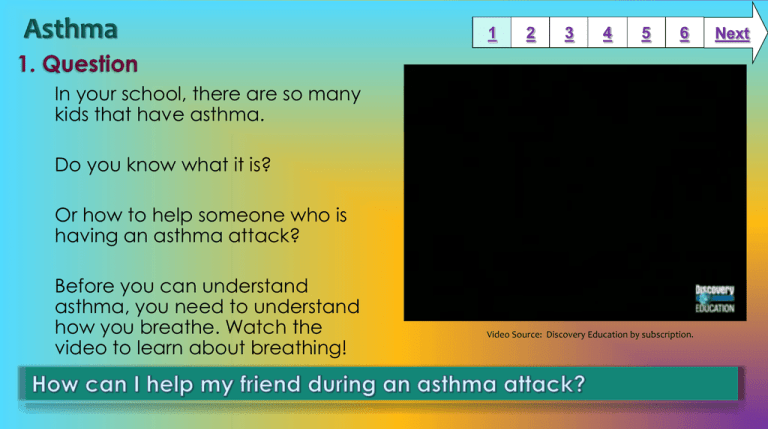
1
2
3
4
5
6
In your school, there are so many
kids that have asthma.
Do you know what it is?
Or how to help someone who is
having an asthma attack?
Before you can understand
asthma, you need to understand
how you breathe. Watch the
video to learn about breathing!
Video Source: Discovery Education by subscription.
Next
1
2
3
4
5
6
Next
Use these resources to help you learn more about what asthma is and how to control it.
I can do on my own.
Challenge me.
What is asthma?
Asthma Basics
Asthma Triggers
Buster’s Breathless Story
Kids in Action
Image Source: clipart.com by subscription.
Video and Image source: KidsHealth.org
Attacking Asthma
Image Source: Microsoft Office.
Asthma Questions and Answers
1
Using the resources on page 2
complete the organizer to
help with your final
assessment.
Image Source: Microsoft Office
2
3
4
5
6
Next
1
Your best friend has asthma and is
spending the weekend with you. You
want to help your friend have a safe and
fun time with you.
You need to create an asthma health
plan PowerPoint in order to have a plan
of what to do if your friend has an
asthma attack.
Use the organizer from slide 3 and what
you have learned to create the health
plan.
Click on the picture to the right to begin.
Use this rubric to help you!
2
3
4
5
6
Next
1
2
3
4
5
6
Next
Buster’s Rap
Buster’s Breathless Story
Buster’s Lung Defender
Remove Asthma
Triggers from your
home
Image Sources: Microsoft Office
1
Grade Level and Content Area
BCPS Curriculum / Maryland State Curriculum
Grade 2: Health: Illness and Disease
Common Core State Standards
Reading: 1. Read closely to determine what the text says explicitly and to make logical inferences from it; cite specific
textual evidence when writing or speaking to support conclusions drawn from the text.
Writing: 7. Conduct short as well as more sustained research projects based on focused questions, demonstrating
understanding of the subject under investigation.
Health Education
7.0 Disease Prevention and Control - Students will demonstrate the ability to apply prevention and treatment
knowledge, skills, and strategies to reduce susceptibility and manage disease.
A. Disease Classification: 1. Describe disease: b. Define non communicable disease
Standards for the 21st Century Learner
1.1.6 Read, view, and listen for information presented in any format (e.g. textual, visual, media, digital) in order to
make inferences and gather meaning.
2.1.3 Use strategies to draw conclusions from information and apply knowledge to curricular areas, real-world
situations, and further investigations.
ISTE NETS - National Educational Technology Standards for Students
3. Research and Information Fluency: Students apply digital tools to gather, evaluate, and use information.
b. Locate, organize, analyze, evaluate, synthesize, and ethically use information from a variety of sources and
media.
4. Critical Thinking, Problem Solving, and Decision Making: Students use critical thinking skills to plan and conduct
research, manage projects, solve problems, and make informed decisions using appropriate digital tools and
resources. c. Collect and analyze data to identify solutions and/or make informed decisions.
2
3
4
5
6
Time Frame: Two 50 minute lessons
Differentiation strategies for this lesson:
Direct students to use the read aloud options on the gold star
enrichment activities.
Information provided for students is on grade level.
Students can work independently, in partners, or small groups
to complete the slam dunk.
Learning Styles addressed in this lesson:
Auditory, Visual, Kinesthetic, Reflective, Sequential, Field
Independent
Notes to the teacher:
Collaborate with your school library media specialist to implement
this lesson.
Students will need headphones to complete this lesson.
Teachers can print the materials needed or it can be done on a
computer.
Students will need access to Microsoft Word and PowerPoint.
Teacher needs to show students how to search for images on
PowerPoint.
Students don’t need to use all the resources available on page two.
Last updated: July 2014
Created by Marlena Aumen, Library Media Specialist Intern
BCPS Slam Dunk Research Model, Copyright 2013, Baltimore County Public Schools, MD, all rights reserved. The models may be used for educational, non-profit school use only.
All other uses, transmissions, and duplications are prohibited unless permission is granted expressly. This lesson is based on Jamie McKenzie’s Slam Dunk Lesson module.




